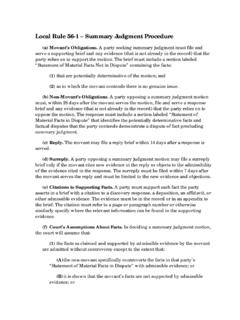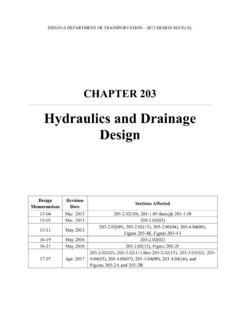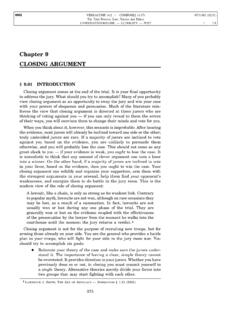Transcription of KEY DIFFERENCES BETWEEN STATE & FEDERAL COURTS
1 LESSON plan :KEY DIFFERENCES BETWEEN STATE & FEDERAL COURTSThis page intentionally left blank1 INTRODUCTIONThe United States District Court for the Southern District of indiana is pleased to present this educational lesson plan on the DIFFERENCES BETWEEN STATE and FEDERAL COURTS . This lesson plan is designed to help teachers engage students in learning about the important role that the judiciary plays in this country's democracy. In the United States, there are two separate court systems - the FEDERAL COURTS and the STATE COURTS . Each court system has jurisdiction over certain types of cases, although there are instances when this jurisdiction overlaps. This lesson plan is designed to examine the similarities and DIFFERENCES BETWEEN STATE and FEDERAL COURTS and to explain the role that both types of COURTS play in the lives of this country's citizens.
2 GRADE LEVELS: This lesson plan can be adapted for middle school or high school use. indiana ACADEMIC STANDARDS: Middle School Civics and Government High School United States Government (USG) Standard 1: The Nature of Politics & Government United States Government (USG) Standard 2: The Foundations of Government in the United States United States Government (USG) Standard 3: Purposes, Principles and Institutions of Government in the United States United States Government (USG) Standard 5: Roles of Citizens in the United States OBJECTIVES: After completing this lesson, a student should be able to: Understand the different roles that STATE and FEDERAL COURTS play in the judicial process and be able to discuss how the COURTS play an important purpose in the lives of citizensKnow the meaning of legal vocabulary termsIdentify the structure of STATE and FEDERAL court systems and be able to discuss similarities and DIFFERENCES BETWEEN the twoDetermine whether a case with certain characteristics would be heard in STATE or FEDERAL court 2 VOCABULARYBANKRUPTCY A legal term describing a situation where an individual or business cannot repay their debts and must seek assistance from a court of law CONCURRENT JURISDICTION A situation that occurs when both STATE and FEDERAL laws govern a particular matter DEFENDANT The individual or entity on trial for a crime or sued in a court of law DISPOSITION To complete a case or case
3 File DISTRICT JUDGE A United States FEDERAL judge, nominated by the President and confirmed by the Senate; a district judge serves as a FEDERAL trial court judge DIVERSITY OF CITIZENSHIP A case involving parties from different states, and amounts of money greater than $75,000 DOUBLE JEOPARDY The prosecution of a person twice for the same crime DUAL SOVEREIGNTY A provision of law allowing for the double prosecution of a person by more than one government for the same crime, because each government entity has jurisdiction to prosecute, notwithstanding the double jeopardy rule FEDERALISM A system of government in which a national government shares power with local entities, such as states or provinces FELONY A serious crime, often involving acts of violence and usually punishable by imprisonment GRAND JURY A jury selected to examine the validity of a case prior to charging an individual with a crime HABEAS CORPUS A provision of law by which a person can report an unlawful imprisonment or detention to a court and request that the court schedule a hearing to determine if the detained person is being lawfully held3 INTERSTATE Existing, or carried out, BETWEEN two or more states JURISDICTION The official power of an entity to make legal decisions and judgments MAGISTRATE JUDGE A FEDERAL judge, appointed to an 8-year term by the judges of a district court.
4 A magistrate judge typically handles pretrial case management, settlement conferences, initial appearances, and other matters as assigned by a district judge MISDEMEANOR A less serious criminal act resulting in a smaller punishment that may or may not include prison time PROSECUTE To begin or continue legal proceedings against a person or organization SOVEREIGN A government holding ultimate authority within its limited sphere 4 KEY CONCEPTSFEDERAL VS. STATE COURT - WHAT'S THE DIFFERENCE? The United States Constitution gives certain powers to the FEDERAL government and reserves the rest for states. This sharing of power is known as federalism. FEDERAL laws are passed by Congress and apply to all states, whereas STATE laws are passed by each individual STATE 's legislature and only apply within that STATE 's boundaries. Since both the FEDERAL government and states have different sets of laws, FEDERAL and STATE COURTS hear different types of cases.
5 FEDERAL COURTS gain their authority from Article III of the United States Constitution. In general, FEDERAL COURTS hear cases arising from Constitutional matters or laws enacted by Congress. STATE COURTS gain their authority from their STATE 's laws. They have authority over matters involving STATE laws. STATE AND FEDERAL COURTS IN indiana indiana 's STATE COURTS : indiana 's STATE court system is made up of trial COURTS , the indiana Court of Appeals, and the indiana Supreme Court. In most indiana counties, trial court judges are elected by voters to six-year terms. In Lake, Allen, Marion, and St. Joseph counties, a lawyer wishing to fill a judicial vacancy must first apply to a local nominating commission. According to the STATE of indiana , "A local judicial nominating commission reviews the applications, interviews the candidates, and selects the best as finalists.
6 The Governor then appoints one of the finalists to fill the open position. After their first term, these judges then run for retention in the general election, allowing voters to decide whether or not to keep them on the bench." (see for more details). Trial COURTS are the point of origination for most cases. They include circuit COURTS , superior COURTS , town/county COURTS , and probate COURTS . If a party chooses to appeal a decision issued by a trial court, the case would go to the indiana Court of Appeals for review, or in certain cases, directly to the indiana Supreme Court. Most appeals in criminal and civil matters are sent to the indiana Court of Appeals. This group of 15 judges reviews appealed cases in panels of three. If parties are unhappy with the ruling of the Court of Appeals, they may ask the indiana Supreme Court to review the decision.
7 It is then up to the indiana Supreme Court to decide whether they will take the case. The indiana Tax Court is an appellate court that primarily hears appeals involving the amount of taxes owed. When a person thinks that they have paid too much in taxes, they can file an appeal with the indiana Tax Court. The court also maintains a small claims docket for processing refunds from the Department of Revenue under $5,000. The small claims docket also handles appeals of final determination on the assessed value made by the STATE Board of Tax Commissioners if the amount is less than $15,000 for a tax year. The indiana Tax Court is presided over by just one judge. The indiana Supreme Court is the highest court of appeal in indiana . There are five justices on the indiana Supreme Court. The court has discretionary jurisdiction ( it decides whether to hear a case) over cases that have first been appealed to the indiana Court of Appeals.
8 It has mandatory jurisdiction ( it must hear the case) over cases involving criminal sentences of death or life in prison. These cases come to the indiana Supreme Court directly from the trial COURTS . 5 The indiana Supreme Court also has original exclusive jurisdiction over admissions to practice law; discipline and disbarment of attorneys; unauthorized practice of law; discipline, removal, and retirement of judges; supervision over the jurisdiction of lower COURTS ; and appeals cases where a STATE or FEDERAL statute was declared unconstitutional. The indiana Supreme Court also maintains the ability to take a case on petition, without it first going through the regular appellate channels, assuming that it involves substantial questions of law, emergency, or tremendous public importance. Court of Appeals judges and Supreme Court Justices are both chosen by merit selection.
9 Prospective judges must submit their names to the STATE Judicial Nominating Commission, who then forwards the names of finalists to the governor. The governor appoints the new judge. The judge is then confirmed by a retention vote in the next regularly scheduled election. If retained, the judge is subject to a retention vote every 10 years. indiana 's FEDERAL COURTS There are two FEDERAL COURTS in indiana : the Northern District of indiana and the Southern District of indiana . The district COURTS function as FEDERAL trial COURTS . Each district operates independently. The Southern District of indiana includes 60 of indiana 's 92 counties and is comprised of four divisions: Indianapolis, Evansville, New Albany, and Terre Haute. The Northern District of indiana includes 32 counties and is comprised of three divisions: Fort Wayne, Hammond, and South Bend.
10 They also have a sub-office in Lafayette. The Southern District of indiana has five full-time district judges and one district judge on senior status.* It also has five full-time magistrate judges and two part-time magistrate judges. The Northern District of indiana has four full-time district judges and four district judges on senior status. It also has five magistrate judges. *Judges on senior status choose what percentage of caseload to retain. District judges are termed Article III judges because their positions are authorized by Article III of the United States Constitution. They are nominated by the President, confirmed by the Senate, and serve lifetime appointments (during what the Constitution calls "good behavior"). Magistrate judges are termed statutory judges because their positions are created and governed solely by Congressional statute.






